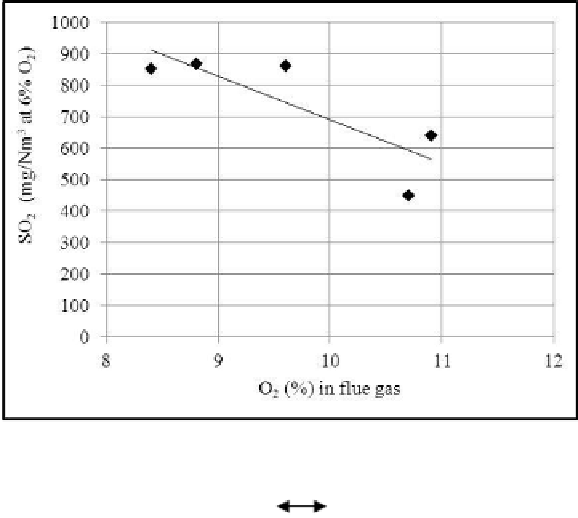Agriculture Reference
In-Depth Information
Table 15. Comparison of SO
2
emissions for Fuels and blends tested
SO
2
(mg/Nm
3
at 6% O
2
)
Fuel
C
a
/S
Mass
Molar
Coal
2500 - 2750
0.06
0.05
Coal-Pressed Pulp blend (50/50)
600 - 1200
0.61
0.49
Coal-Pressed Pulp blend (60/40)
1000 - 1500
0.44
0.35
Coal-Pressed pulp blend (70/30)
1800 - 2400
0.31
0.25
Figure 8. SO
2
vs. O
2
for 50/50 coal-pulp blend (11.8 kW).
2CaO + 2SO
2
+ O
2
2CaSO
4
(7)
The temperature at which maximum sulphur capture efficiency occurs is 800 °C - 900 °C
[Oka and Anthony, 2003] which is within fluidized bed operating temperature range. Change
in sulphation efficiency with variation in temperature in the vicinity of the optimum
temperature is not much. The optimum temperature for maximum SO
2
capture varies from
coal to coal [Fernandez et al. 1989] and from unit to unit. Leckner and Amand, (1987) have
shown that sulphation efficiency reduces significantly when temperature is below 780 °C or
above 960 °C.
Emissions of SO
2
reduce as biomass mass fraction is increased due to fuel sulphur
dilution. Because of low sulphur content of the biomass fuels SO
x
emissions decrease
depending upon the co-firing ratio and the sulphur content of the biomass. The emissions are
found to be lower when co-firing as compared to coal alone firing. An additional incremental
reduction beyond the amount anticipated on the basis of fuel sulphur content is possibly due
to the sulphur retention by alkali compounds in biomass ashes. During co-firing coal and pulp
blends SO
2
emissions were found to be decreased with increase in biomass fraction.
Thus the influence of volatiles on SO
2
emissions depends upon type of biomass fuel as
nature of volatiles varies from fuel to fuel. It is not possible to comment on the effect of
volatiles on SO
2
emissions due to influence of moisture on the emissions. Moreover, energy





























